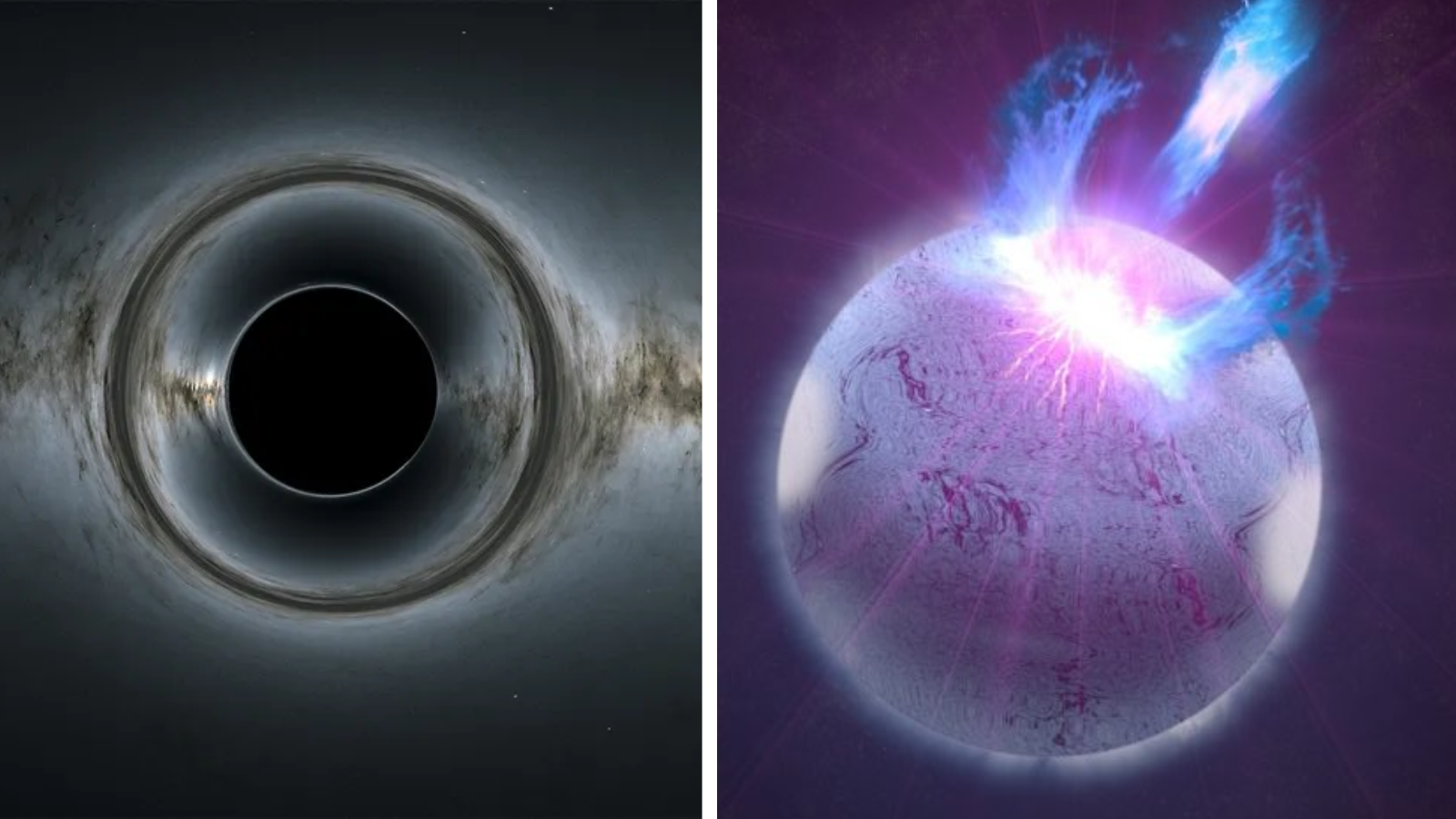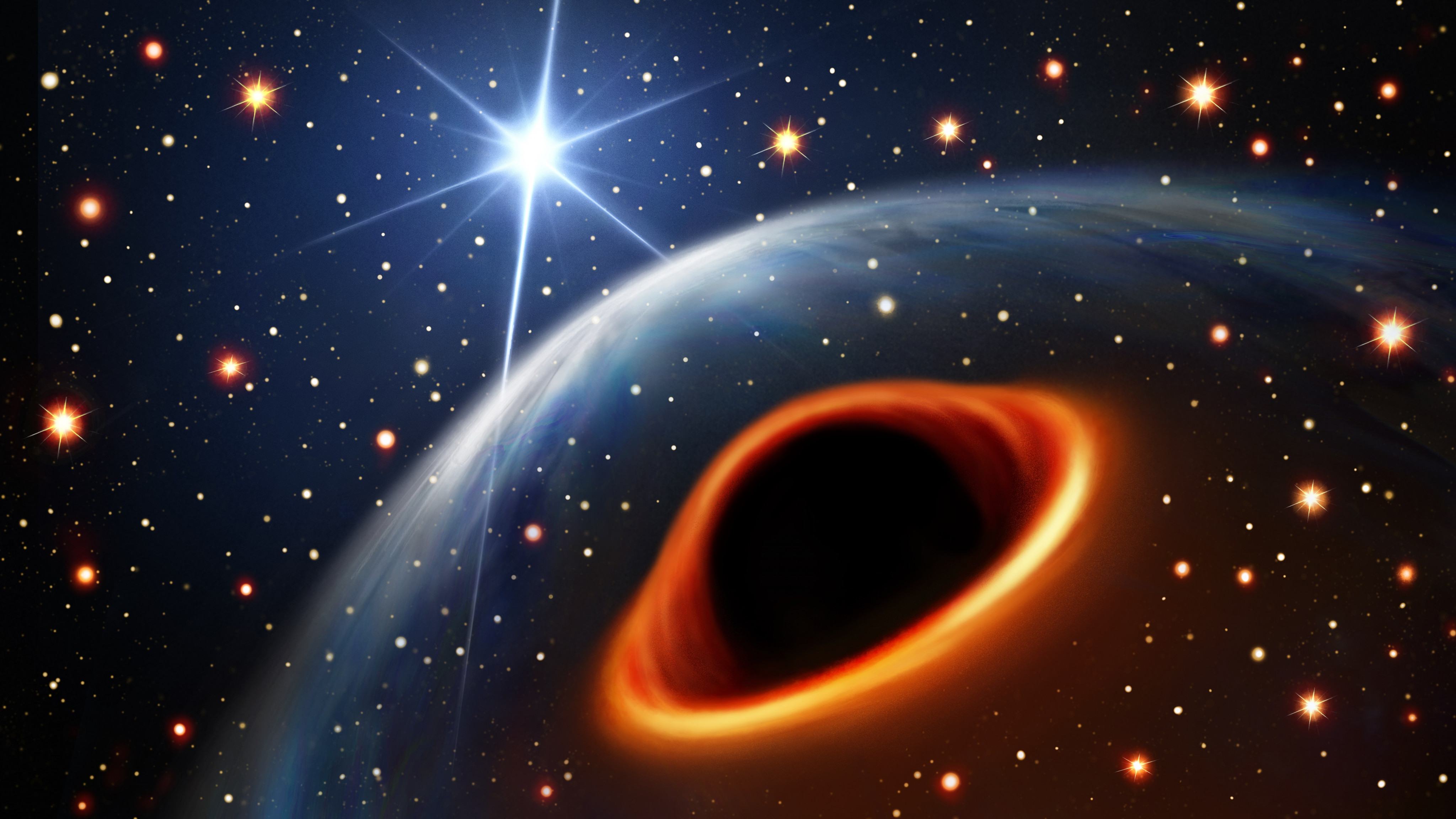
Astronomers have discovered a mystery object in the Milky Way that is more massive than the heaviest neutron star but lighter than the smallest black hole.
The mystery body could help scientists better determine where to draw the dividing line between neutron stars and black holes, both born when a massive star dies.
"Either possibility for the nature of the companion is exciting," team leader and University of Manchester professor of astrophysics Ben Stappers said in a statement. "A pulsar–black hole system will be an important target for testing theories of gravity, and a heavy neutron star will provide new insights into nuclear physics at very high densities."
Related: Scientists discover cosmic fossil created by erupting supermassive black hole
The object was discovered using the MeerKAT Radio Telescope, which is comprised of 64 antennas located in the Northern Cape of South Africa. The dense stellar remnant is orbiting a rapidly spinning neutron star or "millisecond pulsar" located around 40,000 light-years away within a dense clump of stars called a "globular cluster" in the Milky Way.
While a system with two neutron stars would be fascinating, if the mystery object is a black hole, this would make the system an incredibly coveted radio pulsar-black hole binary system. Thanks to the highly periodic outbursts of the pulsar, which can be used as a timing mechanism, and the intense gravitational influence of the black hole, such a system could be crucial for testing the limits of Einstein's 1915 theory of gravity, known as general relativity.
The pulsar, known as PSR J0514-4002E, was spotted via the faint pulses of radio waves it sends out as they sweep over Earth.
As the neutron star rotates at 170 times a second like a cosmic lighthouse, slight changes in the highly regular pulses allowed the researchers to determine PSR J0514-4002E has an orbiting object that is incredibly dense, meaning it can only be the remnant of a massive collapsed star.
The team discovered that the pulsar and the mystery object are separated by 5 million miles (8 million kilometers), about 0.05 times the distance between Earth and the sun, and circle each other once every seven Earth days.
The orbiting object has more mass than any known neutron star but less than any known black hole, landing it right in the black hole mass gap.
Black holes and neutron stars: Spot the difference
Both neutron stars and black holes are born when massive stars reach the end of fuel for nuclear fusion and can no longer support themselves against the inward pressure of their own gravity. The core of the star collapses while the outer layers of this dying star are blown away in a supernova explosion.
At the lower end of the mass scale, the stellar core's collapse is halted by the quantum properties of the sea of neutrons that it is now composed of, and it becomes a neutron star, a stellar remnant with between 1 and 2 times the mass of the sun the width of a city here on Earth, around 12 miles (20 kilometers).
Above a certain mass, however, the quantum pressure that keeps neutrons separated is overcome, and the core undergoes a complete collapse and becomes a black hole. A neutron star can also exceed this limit and collapse into a black hole if it has a companion star that can steal material away from to increase its own mass.
Astronomers think that if a stellar core still has a mass above 2.2 times the mass of the sun after losing its outer layers and the vast majority of its mass, it is heavy enough to birth a black hole.
The problem with this is the lightest black holes we have seen still have around 5 times the mass of the sun. The absence of black holes between 5 solar masses and 2.2 solar masses has become known as the "black hole mass gap," and it casts doubt on the 2.2 solar mass limit for neutron stars.

Closing the black hole mass gap
Stappers and colleagues discovered the object that could be key in solving this mystery and closing the mass gap while using MeerKat to study the globular cluster NGC 1851, located in the southern constellation of Columba.
The stars in this ancient cluster of stars are more tightly bound than stars in the rest of the Milky Way. Stars in NGC 1851 are so crowded they interact with each other, perturbing each other's orbits and even colliding in extreme cases.
The team thinks that such a collision between two neutron stars could have created the mystery object they detected orbiting the pulsar PSR J0514-4002E.
The team can't yet identify if the companion of PSR J0514-4002E is a neutron star, a black hole, or even a hitherto unknown dense cosmic object, but they do know that this system could become a unique cosmic laboratory to study the behavior of matter and physics under extreme conditions.
"We're not done with this system yet," Dutta concluded. "Uncovering the true nature of the companion will be a turning point in our understanding of neutron stars, black holes, and whatever else might be lurking in the black hole mass gap."
The team's research was published on Thursday (Jan. 18) in the journal Science.







